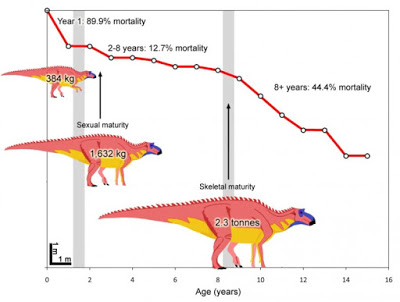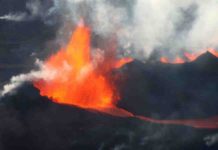
Decades of research on Montana’s state fossil — the “good mother lizard” Maiasaura peeblesorum — has resulted in the most detailed life history of any dinosaur known and created a model to which all other dinosaurs can be compared, according to new research published recently in the journal Paleobiology.
Researchers from Oklahoma State University, Montana State University and Indiana Purdue University used fossils collected from a huge bonebed in western Montana for their study.
“This is one of the most important pieces of paleontology involving MSU in the past 20 years,” said Jack Horner, curator of the Museum of the Rockies at MSU. “This is a dramatic step forward from studying fossilized creatures as single individuals to understanding their life cycle. We are moving away from the novelty of a single instance to looking at a population of dinosaurs in the same way we look at populations of animals today.”
The study was led by Holly Woodward, who did the research as her doctoral thesis in paleontology at MSU. Woodward is now professor of anatomy at Oklahoma State University Center for Health Sciences.
The Paleobiology study examined the fossil bone microstructure, or histology, of 50 Maiasaura tibiae (shin bones). Bone histology reveals aspects of growth that cannot be obtained by simply looking at the shape of the bone, including information about growth rate, metabolism, age at death, sexual maturity, skeletal maturity and how long a species took to reach adult size.
“Histology is the key to understanding the growth dynamics of extinct animals,” Woodward said. “You can only learn so much from a bone by looking at its shape. But the entire growth history of the animal is recorded within the bone.”
A sample of 50 might not sound like much, but for dinosaur paleontologists dealing with an often sparse fossil record, the Maiasaura fossils are a treasure trove.
“No other histological study of a single dinosaur species approaches our sample size,” Woodward said.
With it, the researchers discovered a wealth of new information about how Maiasaura grew up: it had bird-level growth rates throughout most of its life, and its bone tissue most closely resembled that of modern day warm-blooded large mammals such as elk.
Major life events are recorded in the growth of the bones and the rates at which different-aged animals died.
“By studying the clues in the bone histology, and looking at patterns in the death assemblage, we found multiple pieces of evidence all supporting the same timing of sexual and skeletal maturity,” said Elizabeth Freedman Fowler, curator of paleontology at the Great Plains Dinosaur Museum in Malta and adjunct professor at MSU, who performed the mathematical analyses for the study.
Sexual maturity occurred within the third year of life, and Maiasaura reached an average adult mass of 2.3 tonnes in eight years. Life was especially hard for the very young and the old. The average mortality rate for those less than a year of age was 89.9 percent, and 44.4 percent for individuals 8 years and older.
If Maiasaura individuals could survive through their second year, they enjoyed a six-year window of peak physical and reproductive fitness, when the average mortality rate was just 12.7 percent.
“By looking within the bones, and by synthesizing what previous studies revealed, we now know more about the life history of Maiasaura than any other dinosaur and have the sample size to back up our conclusions,” Woodward said. “Our study makes Maiasaura a model organism to which other dinosaur population biology studies will be compared.”
The 50 tibiae also highlighted the extent of individual size variation within a dinosaur species. Previous dinosaur studies histologically examined a small subset of dinosaur bones and assigned ages to the entire sample based on the lengths of the few histologically aged bones.
“Our results suggest you can’t just measure the length of a dinosaur bone and assume it represents an animal of a certain age,” Woodward said. “Within our sample, there is a lot of variability in the length of the tibia in each age group. It would be like trying to assign an age to a person based on their height because you know the height and age of someone else. Histology is the only way to quantify age in dinosaurs.”
Horner, a coauthor on the research and curator of the Museum of the Rockies at MSU where the Maiasaura fossils are reposited, discovered and named Maiasaura in 1979. He made headlines by announcing the world’s first discovery of fossil dinosaur embryos and eggs. Based on the immature development of the baby dinosaur fossils found in nests, Horner hypothesized that they were helpless upon hatching and had to be cared for by parents, so naming the dinosaur Maiasaura, Latin for “good mother lizard.”
Studies that followed revealed aspects of Maiasaura biology including that they were social and nested in colonies; Maiasaura walked on two legs when young and shifted to walking on all four as they got bigger; their preferred foods included rotting wood; and that their environment was warm and semi-arid, with a long dry season prone to drought.
The tibiae included in the Paleobiology study came from a single bonebed in western Montana covering at least two square kilometers. More than 30 years of excavation and thousands of fossils later, the bonebed shows no signs of running dry. Woodward plans to lead annual summer excavations of the Maiasaura bonebed to collect more data.
“Our study kicks off The Maiasaura Life History Project, which seeks to learn as much as possible about Maiasaura and its environment 76 million years ago by continuing to collect and histologically examine fossils from the bonebed, adding statistical strength to the sample,” she said.
“We plan to examine other skeletal elements to make a histological ‘map’ of Maiasaura, seeing if the different bones in its body grew at different rates, which would allow us to study more aspects of its biology and behavior. We also want to better understand the environment in which Maiasaura lived, including the life histories of other animals in the ecosystem,” she added.
The Maiasaura Life History Project will also provide opportunities for college-aged students accompanying Woodward in her excavations to learn about the fields of ecology, biology and geology, thereby encouraging younger generations to pursue careers in science.
In addition to Woodward, Horner and Freedman Fowler, James Farlow, professor emeritus of Geology at Indiana Purdue University, contributed to the Paleobiology paper.
Reference:
Holly N. Woodward, Elizabeth A. Freedman Fowler, James O. Farlow, John R. Horner. Maiasaura, a model organism for extinct vertebrate population biology: a large sample statistical assessment of growth dynamics and survivorship. Paleobiology, 2015; 1 DOI: 10.1017/pab.2015.19
Note: The above post is reprinted from materials provided by Montana State University.










